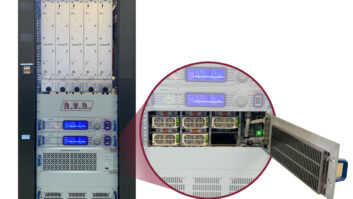As I travel around different facilities, I find there is confusion on the proper way to confirm and measure IBOC mask and spectrum compliance.
The most common mistakes in completing spectrum measurements are employing improper tools, choosing an improper measurement location and using improper spectrum analyzer configuration.
Improper power calculations and modulation levels also may result in inaccurate measurements.
Some of the biggest and easiest mistakes relate to measurement in space and high-level systems. Measurement is not simply a matter of taking a spectrum plot at a modulation sample of the digital transmitter. There is more involved.
Some manufacturers have employed spectrum analyzer options in their modulation monitoring equipment. While these are great visual aids in troubleshooting, they unfortunately are not very helpful for verifying compliance with the mask.
Typically signal-to-noise levels exceed the minimum levels of IBOC mask compliance (–80 dB). Multipath and location within any FM pattern if separate radiators are employed and if you are taking an off-air sample can adversely affect results.
The tools required to make the measurements are:
- A good spectrum analyzer (Agilent 4402b or like specifications)
- Directional Sample and appropriate RF line sections (When measuring for spectrum compliance you must use a directional sample to avoid the effects of the return path signals interfering with your measurements.)
- 2 or more fixed 3 dB or larger RF pads
- A Variable RF attenuator (typically with 30 dB of selectable step attenuation)
- Test cables and a splitter/combiner like the mini-circuits ZFSC-2-2.
High-level methods
High-level, also referred to as “separate amplification,” employs independent digital and analog transmitters. The output of each is later combined using RF combiner.
(click thumbnail)Fig. 1Common combiner ratios are 8 and 10 dB. Fig. 1 is representative of a well-designed high-level deployment, where separate transmitters are used for HD-R and analog signals. Three switches are employed to allow you to bypass the combiner/injector or use the digital transmitter as a back-up analog transmitter.
The “Ws” represent sample port line sections or wattmeter sections with slug ports. Common models are the Bird Electronics BPME or standard 4610. Without these sections, there is no way to sample RF properly for IBOC mask compliance.
You must measure using a directional sample with at least 30 dB directivity at the last location before the antenna. Coupling does not matter as levels will be set using fixed or variable external pads.
Split-level is trademarked by Harris Broadcast and is only available from that company. The method splits off some of the analog RF into the digital transmitter. The primary advantage is that your analog transmitter does not have to make the 10 percent headroom for high-level operation.
You can avoid an analog transmitter replacement by shifting some of the analog into the digital transmitter. Split-level is measured at the same location and using the same method as high-level, just before the transmission line leaves the building and after any filters, but before the antenna.
Low-level is exciter-based injection. Where low-level HD Radio RF is injected into either a linear RF amplifier and/or pre-correction is employed to assist. In low-level systems, place a line section between the transmitter and antenna and after any filters in the system, such as the low pass filter.
To summarize high-, split- and low-level systems: Sample via directional coupler with at least 30 dB directivity on the output, after any filters in the system and before the antenna. Place sample sections in the output line, in the dummy load line for testing and sample purposes.
Do not use modulation monitor samples on your transmitters. They frequently have no directivity and are located before the low pass filters. (We only care about what makes it to the antenna and is radiated, right?)
Do not measure an off-air sample for IBOC FM mask compliance. There will be antenna effects on received signal, possible signal corruption from multipath and differences in antenna patterns. All will cause non-linear measurements across the channel. Also the SNR is typically higher than the mask minimums of –80 dB.
Separate or dual-feed
Space systems are a challenge to measure. It is not sufficient to measure just the digital signal. You must measure the analog and digital together to allow them to mix and generate IM products.
Hopefully your analog and digital antenna patterns are similar. However, if separate antennas are employed, the coverage will never be exactly the same in any location due to reflections from the mounting structure, differences in HAAT and number of elements employed, and therefore, differences in elevation pattern.
Dual-fed antennas frequently are counter-polarized, which may change the multipath performance for the two signals under test. Frequently the signal received at your studio or measurement location, will vary widely when the measured source is on the digital antenna vs. the analog antenna. It is possible to make a measurement in a minima of the digital antenna and a maxima of the analog depending on location; however this will cause the ratio of digital to analog to suffer.
So what’s the solution? Combine and measure before the antennas.
(click thumbnail)Fig. 2In the procedure shown in Fig. 2, we see there are two directional couplers, one placed in the analog line and one in the digital line, along with a few pads and a 3 dB hybrid, such as the Mini-circuits ZFSC-2-2. You can verify IM products are compliant with the IBOC mask by combining the signals from the directional couplers in the mini-circuits combiner.
This method cannot be used to verify digital injection/transmission levels vs. the analog. We need to depend on power loss and gain calculations given the different losses and gains most likely employed in any space system.
Under the current rules — that feels good to say; we have rules now! — the digital ERP is injected at a level of 1 percent of the analog. In space systems, you will have separate transmission lines and maybe two antennae, thus your gains and losses may be different between the systems.
To figure those, we take the ERP required and divide it by the power gain of the antenna. (You also can do a dB conversion.) Then subtract the line and other system losses. Examples of other losses encountered are switches and any combiners and filters.
Since losses will be different between systems, so will the TPO and therefore the measured level at the directional couplers. In the procedure shown, we reference the analog signal level and then adjust the variable RF pad on the digital feed to set the digital reference level to 20 dB below the analog.
First, we need to calibrate the analog reference by removing the digital signal cable. We leave the pad on the digital side to maintain the hybrid isolation of the mini-circuits combiner.
Now, set the resolution and video bandwidth to 1 MHz and peak the carrier to some level, typically the top of the display. The result is the level to which all other measurements will reference.
Next, we mark the analog level with a delta marker and then we remove the analog and place the digital signal in the mini-circuits combiner and set the resolution and video bandwidth to 1 MHz again. This time we will add pads to drop the “line” (level) to 20 dB below your analog reference. You should adjust the variable RF pad on the digital feed to set the digital level.
In a recent measurement, the analog reference level of approximately –10 dBm was measured without the digital connected to the mini-circuits combiner. Then the digital reference level was measured at –24 dBm.
The difference between the signals is 14 dB, thus 6 dB of additional attenuation should be placed on the digital side of the splitter combiner so that the digital reference level will be –20 dB below the analog reference level. The actual level is –22.6 dB down from analog. You should not reference the “top of the skirts” on the limits screen if loaded. You will cheat yourself out of a few dB of headroom.
Once the digital reference is set using the external pads we reconnect the analog signal and change your resolution bandwidth to 1 kHz and make the measurement. For FM measurements your analyzer should be configured with the following settings:


- Resolution Bandwidth: 1 kHz
- Span 2 MHz
- Detect Peak = Off or Sample
- Average = ON 100 samples
- Sweep: auto
- Sample points = 400 to tune 8000 to measure
- Marker set to peak delta
- Marker set to reference level
- Average type PWR
A couple of notes on spectrum analyzer configuration: There are differing points of view among manufacturers relating to the “average type setting” to employ. The “average type” conservative setting is PWR.
Typically video sampling will return readings approximately 1 to 1.5 dB lower than when power sampling is employed and therefore power sampling is recommended as it will return worst-case levels. Most transmitter manufacturers are using video sampling in their built-in displays, as the power sampling is a recent technology advancement.
You should decide whether a fixed or slug option is best for your installation.
I will cover AM measurements in a future article.
This article includes information from “FM HD Radio Measurements Dual-Input Antenna Systems or Separate Analog and Digital Antennas (Space Combined)” by Randy Mullinax, 2006 white paper; “FM-IBOC RF Output Signal Viewing Agilent 4402B Spectrum Analyzer Setup,” Harris 2004 white paper; “Use Correct Size Directional Sample,” Randy Mullinax 2005 PowerPoint.












